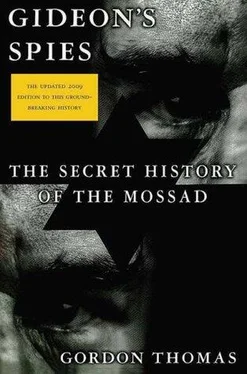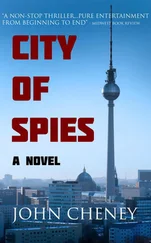Gordon Thomas - Gideon's Spies
Здесь есть возможность читать онлайн «Gordon Thomas - Gideon's Spies» весь текст электронной книги совершенно бесплатно (целиком полную версию без сокращений). В некоторых случаях можно слушать аудио, скачать через торрент в формате fb2 и присутствует краткое содержание. Город: New York, Год выпуска: 2009, ISBN: 2009, Издательство: Thomas Dunne Books, Жанр: История, на английском языке. Описание произведения, (предисловие) а так же отзывы посетителей доступны на портале библиотеки ЛибКат.
- Название:Gideon's Spies
- Автор:
- Издательство:Thomas Dunne Books
- Жанр:
- Год:2009
- Город:New York
- ISBN:978-0-312-53901-6
- Рейтинг книги:4 / 5. Голосов: 1
-
Избранное:Добавить в избранное
- Отзывы:
-
Ваша оценка:
- 80
- 1
- 2
- 3
- 4
- 5
Gideon's Spies: краткое содержание, описание и аннотация
Предлагаем к чтению аннотацию, описание, краткое содержание или предисловие (зависит от того, что написал сам автор книги «Gideon's Spies»). Если вы не нашли необходимую информацию о книге — напишите в комментариях, мы постараемся отыскать её.
Gideon’s Spies
Gideon's Spies — читать онлайн бесплатно полную книгу (весь текст) целиком
Ниже представлен текст книги, разбитый по страницам. Система сохранения места последней прочитанной страницы, позволяет с удобством читать онлайн бесплатно книгу «Gideon's Spies», без необходимости каждый раз заново искать на чём Вы остановились. Поставьте закладку, и сможете в любой момент перейти на страницу, на которой закончили чтение.
Интервал:
Закладка:
Working with information from Mossad’s twenty-four stations around the world, the psychologists had proved that Arafat controlled a financial portfolio estimated to be in the region of US$6.5 billion. Yet the Palestinian Authority, which administered the PLO territories in the Gaza Strip and the West Bank, was close to bankruptcy.
LAP had planted a story in a Cairo-based newspaper, Al-Ahram Weekly, that Abdul Jawwad Saleh, a leading member of the Authority, wanted Arafat’s financial adviser, Mohammed Rachid—who controlled the PLO portfolio—to be questioned. Soon newspapers and TV stations in the Gulf Straits, Jordan, Syria, and Lebanon found themselves in possession of copies of a highly secret PLO report that showed that for years the PLO had a deficit of over US$95 million a month. The story became even more explosive when the IMF (International Monetary Fund) revealed Arafat had diverted “one billion U.S. dollars or more of PLO funds from 1995 to 2000.”
The story swept like a desert storm through the Arab world. A Palestinian lawyer who had investigated PLO corruption said he knew of four Arafat loyalists who held secret Swiss bank accounts. The lawyer provided details of widespread corruption. He revealed (to the author on a guarantee of anonymity): “The deals involved the cement and building industries of the Palestinian territories. The corruption ran into millions of dollars, which Arafat covered up in return for the profiteers giving him a portion. He was the godfather of all the other godfathers.”
The effect was to weaken the PLO at a time when, if it was to establish a bargaining position with Israel’s prime minister Sharon, it needed to provide a strong and united front. By focusing on the undoubted murky world of Arafat’s financial dealings, LAP had also effectively ended further speculation about any role Mossad had in his death. It was a textbook example of what Rafi Eitan had once said (to the author): “Well-placed words are often as effective as a bomb.”
The deconstruction of Arafat’s image was only part of Mossad’s role in Israel’s information warfare, infowar, which had become the hottest concept in the Kirya, the Israeli Defense Forces headquarters. Infowar was designed to exploit the ever-advancing technological concepts of the late twentieth century to allow Israel to launch swift, stealthy, widespread, and devastating assaults on an economic, military, and civilian infrastructure before an attack could be launched. Prime targets were Syria and Iran.
Powerful computer microprocessors and sophisticated sensors, and the training to use them, had been provided by the United States under yet another sweetheart deal Sharon had negotiated with the Bush administration.
IDF officers and several Mossad specialists had been sent to the National Defense University in Washington and the Naval War College at Newport, Rhode Island, to learn how to cripple enemy stock markets and morph images of a foreign leader. A favorite among the Israeli students was a tape of the ayatollahs appearing on Iranian television sipping whisky and carving slices from a ham, both forbidden in Islam. Before they had graduated, the students had flown on Commando Solo, the customized former USAF cargo plane that had been given a $70 million refit that enabled its crew to jam a country’s TV and radio broadcasts and substitute messages—true or false—on any frequency. A version of the plane had been acquired by the IDF.
Mossad technicians were researching ways to infect enemy computer systems with a variety of virulent strains of software viruses. They would include the “logic bomb,” designed to remain dormant in an enemy system until a predetermined time when it would be activated and begin to destroy stored data. Such a bomb could attack an enemy’s air defence system or a central bank. The technicians had already created a program that could insert booby-trapped computer chips into weapons a foreign arms manufacturer planned to sell to a hostile country like Iran or Syria. Mossad katsas in key Eastern Europe arms manufacturing countries had also been briefed to find independent software contractors who wrote programs for such weapons systems. They would be offered substantial sums to slip viruses into the systems. An Israeli specializing in information technology said (to the author): “When the weapons system goes into attack mode, everything about it works, but the warhead doesn’t explode.”
Mossad agents were now equipped with a briefcase-size device that generated a high-powered electromagnetic pulse. Placed near a building, the pulse burned out all electronic components in the building. The device had its own built-in self-destruct mechanism that ensured its innards remained a secret. At the Institute for Biological Research, scientists were working to see if microbes could be bred to eat the electronics and insulating material inside computers in the same way that microorganisms consumed trash. Other scientists were working on aerosols that could be sprayed over enemy troops. Biosensors flying overhead would then track their movements from their breath or sweat.
On the other floors below, where the specialists created their Web site entries about Yasser Arafat, other equally skilled experts were going about their work.
The Research and Development laboratories on the second floor continued to create and update surveillance devices and adapt weapons. From there had come the matchbox-size camera, which could record and photograph a subject at over sixty yards’ distance, and a variety of knives, including one that could slice through a spinal cord. These had been designed for the kidon, the unit specializing in assassination.
The third floor was occupied by the archives and the liaison offices with Shin Bet—Israel’s equivalent of the FBI, with responsibility for Israel’s internal security and foreign intelligence services that were deemed friendly. These included the CIA. Britain’s MI6, French and German services, and the Russian Foreign Intelligence Service. Part of the floor was allocated to the Collections Department. This collated all incoming intelligence and distributed it to the appropriate departments on a need-to-know basis. The archives received everything; the data would be stored on high-speed Honeywell computers.
These included psychoprofiles of world leaders, terrorists, politicians, leading financiers—anyone who could be a help or hindrance to Israel. A typical profile contained personal details and close relationships. The one on President Bill Clinton listed the many transcripts from a yaholomin surveillance of his conversations with Monica Lewinsky, some verging on phone-sex calls (see chapter 5, “Gideon’s Nuclear Sword,” pp. 103–5). The profile of Hillary Clinton contained a close analysis of her contact with Vince Foster, the Clinton White House deputy counsel. Mossad concluded that Foster did not commit suicide but, according to one Mossad officer who had read the file, “most likely was murdered to cover up what was a serious attempt by persons in the Clinton White House to keep secret material they would have preferred to keep quiet” (the author was told).
Osama bin Laden had an entire shelf of computer discs divided into his speeches, his sightings since 9/11, and the structure and restructure of al-Qaeda. In painstaking detail his profile explored how he had created the plans that had led to more innocent people being killed in the West than had died in Europe during any conflict since the Second World War. The analysis of his speeches showed bin Laden to be a slave to literal interpretations; the usual intellectual extrapolations upon which much European thinking depends appeared to be beyond his range. A late entry was the appointment of his eldest son, Saad, as his successor, and in the meantime the instructions were to concentrate on developing strategies for attacks on U.S. targets. The announcement had come from “the Jerusalem Force,” the name bin Laden used when addressing his followers as a reminder of his ultimate ambition to ride in triumph through that city. A transcript of the message promised: “when that day comes our son Saad will ride at the head of our great cause.” The Mossad analysts had concluded that the words were a further sign bin Laden did not expect to live long enough to see such an event. A separate file on Saad gave his age, twenty-six, and described him as the son of bin Laden’s first wife and his favorite among the other twenty-three children he had fathered. The file described Saad as “the mirror image of his father, both physically and mentally.” It revealed Saad had served with his father in Afghanistan and had fought against the Soviet occupiers. “Americans who met him there recall his readiness to kill.” The last entry in the file said that Saad was on Mossad’s list for assassination by kidon.
Читать дальшеИнтервал:
Закладка:
Похожие книги на «Gideon's Spies»
Представляем Вашему вниманию похожие книги на «Gideon's Spies» списком для выбора. Мы отобрали схожую по названию и смыслу литературу в надежде предоставить читателям больше вариантов отыскать новые, интересные, ещё непрочитанные произведения.
Обсуждение, отзывы о книге «Gideon's Spies» и просто собственные мнения читателей. Оставьте ваши комментарии, напишите, что Вы думаете о произведении, его смысле или главных героях. Укажите что конкретно понравилось, а что нет, и почему Вы так считаете.












